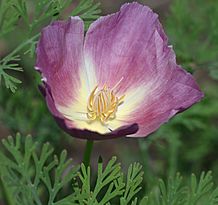California poppy facts for kids
The California poppy (scientific name: Eschscholzia californica) is a beautiful flowering plant. People also call it the golden poppy, California sunlight, or cup of gold. It belongs to the poppy family and grows naturally in the United States and Mexico.
Many people grow it in their gardens because of its bright, cup-shaped flowers. These flowers bloom in summer and can be red, orange, yellow, or sometimes pink. The California poppy is also used in cooking as a food or a decoration. In 1903, it became the official state flower of California.
Quick facts for kids California poppy |
|
|---|---|
 |
|
| Conservation status | |
| Scientific classification | |
| Genus: |
Eschscholzia
|
| Species: |
californica
|
Contents
What Does the California Poppy Look Like?
The California poppy can be a perennial plant (meaning it lives for more than two years) or an annual plant (meaning it lives for one year). It grows from about 5 to 60 inches (13 to 150 cm) tall. Its leaves are a pretty blue-green color and branch out.
The leaves are divided into round, lobed parts. Each flower grows alone on a long stem. They feel silky and have four petals. Each petal is about 2 to 6 cm (0.8 to 2.4 inches) long and wide. The flowers can be yellow, orange, red, or sometimes pink.
California poppies usually bloom from February to September. Their petals close at night or when the weather is cold and windy. They open again in the morning, but might stay closed on cloudy days. After blooming, the plant produces a long, thin seed pod. This pod splits open to release many small black or dark brown seeds. In places with mild winters, the plant survives. In colder areas, it dies completely.
Where Do California Poppies Grow?
California poppies grow naturally in California. Their habitat also reaches into Oregon, Washington, Nevada, Arizona, New Mexico, and parts of Mexico.
A famous place to see them is the Antelope Valley California Poppy Reserve in northern Los Angeles County. When they are blooming, the orange flowers cover almost 1,745 acres (706 hectares) of the reserve. Other large poppy fields can be found in Bear Valley and Point Buchon.
How Was the California Poppy Named?
The California poppy was the first plant in its group (genus Eschscholzia) to be given a name. A German botanist named Adelbert von Chamisso named it after his friend and fellow botanist, Johann Friedrich von Eschscholtz. They were on a scientific trip to California around 1810.

The California poppy has many different forms. Some scientists recognize two main types, called subspecies:
- E. californica subsp. californica: This type grows along the coast of California, Baja California, and Oregon. It is often planted in gardens and can spread to new areas.
- E. californica subsp. mexicana: This type is called the Mexican Gold Poppy and grows in the Sonoran Desert.

Pollen Production
California poppies produce a lot of pollen. A study in the UK found that they ranked very high in pollen production compared to other common flowers. However, they do not produce much nectar.
Because poppies are not pollinated by wind, their pollen usually does not cause allergy problems for people who breathe it in.
What Are California Poppies Used For?
The leaves of the California poppy can be used as food or as a decoration on dishes. The seeds are also used in cooking.
Growing California Poppies
California poppies are easy to grow. They can survive dry weather and often reseed themselves (meaning their seeds fall and grow new plants). They grow best in full sun and sandy, well-drained soil.
Gardeners have created many different types of California poppies, called cultivars. These types have different colors and shapes of blossoms and stems. However, if you plant seeds from these special types, they might not grow into the exact same plant. Seeds are often sold in mixtures.
Can California Poppies Become Invasive?
Because they are so beautiful and easy to grow, California poppies have been planted in many places around the world. These places often have climates similar to California, like parts of Australia, South Africa, Chile, and Argentina.
Sometimes, the California poppy can become an invasive species. This means it spreads quickly and can take over areas where it wasn't originally found. In Chile, for example, it was brought over in the mid-1800s. It was likely imported as a garden plant and also accidentally with alfalfa seeds. Since Chile and California have similar climates, the poppy thrived there.
In Chile, the poppies seem to grow larger and produce more seeds than they do in their native California. Scientists think this might be because they have more resources, less competition from other plants, or fewer natural enemies in their new home.
California's State Flower

In the 1890s, a woman named Sara Plummer Lemmon worked hard to make the golden poppy the state flower of California. She wrote the bill that the California Legislature passed, and Governor George Pardee signed it in 1903.
Today, as the official state flower, Eschscholzia californica is shown on "Welcome to California" signs along highways. You can also see it on official Scenic Route signs in California.













